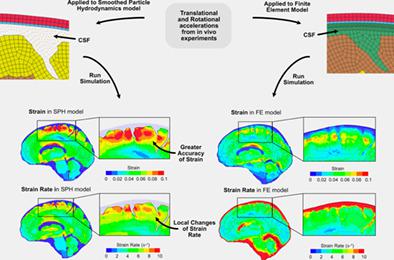当前位置:
X-MOL 学术
›
Int. J. Numer. Method. Biomed. Eng.
›
论文详情
Our official English website, www.x-mol.net, welcomes your feedback! (Note: you will need to create a separate account there.)
Smoothed particle hydrodynamic modelling of the cerebrospinal fluid for brain biomechanics: Accuracy and stability
International Journal for Numerical Methods in Biomedical Engineering ( IF 2.1 ) Pub Date : 2021-01-22 , DOI: 10.1002/cnm.3440 Harry Duckworth 1, 2 , David J Sharp 2, 3 , Mazdak Ghajari 1
International Journal for Numerical Methods in Biomedical Engineering ( IF 2.1 ) Pub Date : 2021-01-22 , DOI: 10.1002/cnm.3440 Harry Duckworth 1, 2 , David J Sharp 2, 3 , Mazdak Ghajari 1
Affiliation

|
The Cerebrospinal Fluid (CSF) can undergo shear deformations under head motions. Finite Element (FE) models, which are commonly used to simulate biomechanics of the brain, including traumatic brain injury, employ solid elements to represent the CSF. However, the limited number of elements paired with shear deformations in CSF can decrease the accuracy of their predictions. Large deformation problems can be accurately modelled using the mesh‐free Smoothed Particle Hydrodynamics (SPH) method, but there is limited previous work on using this method for modelling the CSF. Here we explored the stability and accuracy of key modelling parameters of an SPH model of the CSF when predicting relative brain/skull displacements in a simulation of an in vivo mild head impact in human. The Moving Least Squares (MLS) SPH formulation and Ogden rubber material model were found to be the most accurate and stable. The strain and strain rate in the brain differed across the SPH and FE models of CSF. The FE mesh anchored the gyri, preventing them from experiencing the level of strains seen in the in vivo brain experiments and predicted by the SPH model. Additionally, SPH showed higher levels of strains in the sulci compared to the FE model. However, tensile instability was found to be a key challenge of the SPH method, which needs to be addressed in future. Our study provides a detailed investigation of the use of SPH and shows its potential for improving the accuracy of computational models of brain biomechanics.
中文翻译:

用于脑生物力学的脑脊液平滑粒子流体动力学模型:准确性和稳定性
脑脊液 (CSF) 可以在头部运动下发生剪切变形。有限元 (FE) 模型通常用于模拟大脑的生物力学,包括外伤性脑损伤,使用实体元素来表示 CSF。然而,有限数量的元素与 CSF 中的剪切变形配对会降低其预测的准确性。大变形问题可以使用无网格平滑粒子流体动力学 (SPH) 方法进行准确建模,但之前使用这种方法对 CSF 进行建模的工作有限。在这里,我们探索了 CSF 的 SPH 模型的关键建模参数的稳定性和准确性,在模拟人类的体内轻度头部撞击时预测相对大脑/头骨位移。移动最小二乘法 (MLS) SPH 公式和 Ogden 橡胶材料模型被发现是最准确和最稳定的。脑中的应变和应变率在脑脊液的 SPH 和 FE 模型中有所不同。FE 网格锚定回旋,防止它们经历在体内大脑实验中看到并由 SPH 模型预测的应变水平。此外,与 FE 模型相比,SPH 在脑沟中显示出更高水平的应变。然而,发现拉伸不稳定性是 SPH 方法的一个关键挑战,需要在未来解决。我们的研究对 SPH 的使用进行了详细调查,并显示了其在提高脑生物力学计算模型准确性方面的潜力。脑中的应变和应变率在脑脊液的 SPH 和 FE 模型中有所不同。FE 网格锚定回旋,防止它们经历在体内大脑实验中看到并由 SPH 模型预测的应变水平。此外,与 FE 模型相比,SPH 在脑沟中显示出更高水平的应变。然而,发现拉伸不稳定性是 SPH 方法的一个关键挑战,需要在未来解决。我们的研究对 SPH 的使用进行了详细调查,并显示了其在提高脑生物力学计算模型准确性方面的潜力。脑中的应变和应变率在脑脊液的 SPH 和 FE 模型中有所不同。FE 网格锚定回旋,防止它们经历在体内大脑实验中看到并由 SPH 模型预测的应变水平。此外,与 FE 模型相比,SPH 在脑沟中显示出更高水平的应变。然而,发现拉伸不稳定性是 SPH 方法的一个关键挑战,需要在未来解决。我们的研究对 SPH 的使用进行了详细调查,并显示了其在提高脑生物力学计算模型准确性方面的潜力。与 FE 模型相比,SPH 在脑沟中显示出更高水平的应变。然而,发现拉伸不稳定性是 SPH 方法的一个关键挑战,需要在未来解决。我们的研究对 SPH 的使用进行了详细调查,并显示了其在提高脑生物力学计算模型准确性方面的潜力。与 FE 模型相比,SPH 在脑沟中显示出更高水平的应变。然而,发现拉伸不稳定性是 SPH 方法的一个关键挑战,需要在未来解决。我们的研究对 SPH 的使用进行了详细调查,并显示了其在提高脑生物力学计算模型准确性方面的潜力。
更新日期:2021-01-22
中文翻译:

用于脑生物力学的脑脊液平滑粒子流体动力学模型:准确性和稳定性
脑脊液 (CSF) 可以在头部运动下发生剪切变形。有限元 (FE) 模型通常用于模拟大脑的生物力学,包括外伤性脑损伤,使用实体元素来表示 CSF。然而,有限数量的元素与 CSF 中的剪切变形配对会降低其预测的准确性。大变形问题可以使用无网格平滑粒子流体动力学 (SPH) 方法进行准确建模,但之前使用这种方法对 CSF 进行建模的工作有限。在这里,我们探索了 CSF 的 SPH 模型的关键建模参数的稳定性和准确性,在模拟人类的体内轻度头部撞击时预测相对大脑/头骨位移。移动最小二乘法 (MLS) SPH 公式和 Ogden 橡胶材料模型被发现是最准确和最稳定的。脑中的应变和应变率在脑脊液的 SPH 和 FE 模型中有所不同。FE 网格锚定回旋,防止它们经历在体内大脑实验中看到并由 SPH 模型预测的应变水平。此外,与 FE 模型相比,SPH 在脑沟中显示出更高水平的应变。然而,发现拉伸不稳定性是 SPH 方法的一个关键挑战,需要在未来解决。我们的研究对 SPH 的使用进行了详细调查,并显示了其在提高脑生物力学计算模型准确性方面的潜力。脑中的应变和应变率在脑脊液的 SPH 和 FE 模型中有所不同。FE 网格锚定回旋,防止它们经历在体内大脑实验中看到并由 SPH 模型预测的应变水平。此外,与 FE 模型相比,SPH 在脑沟中显示出更高水平的应变。然而,发现拉伸不稳定性是 SPH 方法的一个关键挑战,需要在未来解决。我们的研究对 SPH 的使用进行了详细调查,并显示了其在提高脑生物力学计算模型准确性方面的潜力。脑中的应变和应变率在脑脊液的 SPH 和 FE 模型中有所不同。FE 网格锚定回旋,防止它们经历在体内大脑实验中看到并由 SPH 模型预测的应变水平。此外,与 FE 模型相比,SPH 在脑沟中显示出更高水平的应变。然而,发现拉伸不稳定性是 SPH 方法的一个关键挑战,需要在未来解决。我们的研究对 SPH 的使用进行了详细调查,并显示了其在提高脑生物力学计算模型准确性方面的潜力。与 FE 模型相比,SPH 在脑沟中显示出更高水平的应变。然而,发现拉伸不稳定性是 SPH 方法的一个关键挑战,需要在未来解决。我们的研究对 SPH 的使用进行了详细调查,并显示了其在提高脑生物力学计算模型准确性方面的潜力。与 FE 模型相比,SPH 在脑沟中显示出更高水平的应变。然而,发现拉伸不稳定性是 SPH 方法的一个关键挑战,需要在未来解决。我们的研究对 SPH 的使用进行了详细调查,并显示了其在提高脑生物力学计算模型准确性方面的潜力。



























 京公网安备 11010802027423号
京公网安备 11010802027423号